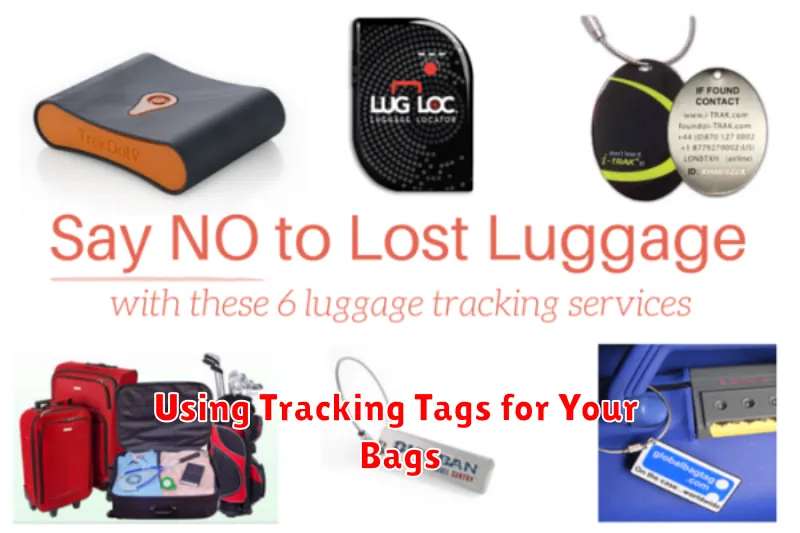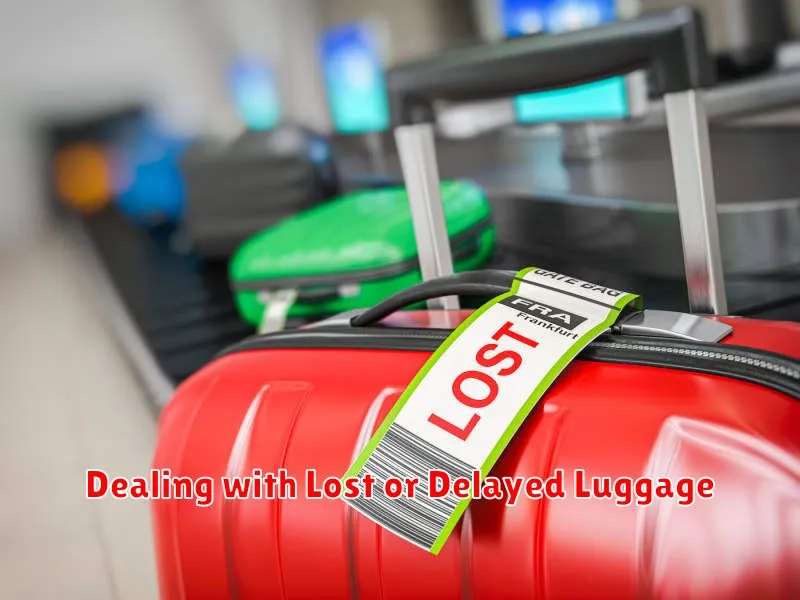Few things can disrupt the start of a trip like lost or delayed luggage. Whether you’re heading out on a business trip, a long-awaited vacation, or returning home, the inconvenience and stress of missing bags can be significant. This article provides helpful guidance on how to deal with lost luggage and navigate the often frustrating process of luggage recovery. Learn how to report lost luggage effectively, understand your passenger rights, and take steps to mitigate the impact of delayed baggage. From tracking your luggage to understanding airline liability for lost baggage, we’ll cover the essential steps you need to take.
Dealing with lost luggage can feel overwhelming, but being prepared and knowing the right procedures can significantly ease the process. This guide will equip you with the knowledge to handle delayed luggage situations confidently, outlining best practices for reporting missing luggage, tracking your bags, and communicating effectively with airline representatives. We’ll also address common questions about compensation for lost luggage and offer proactive strategies to prevent lost or delayed baggage in the future, allowing you to focus on enjoying your travel experience rather than worrying about your belongings.
Reporting Luggage Loss Immediately
Immediately upon realizing your luggage is missing, locate the airline’s baggage service office at the airport. This is typically near the baggage claim area. Provide them with your baggage claim tag, flight information, and a detailed description of your missing luggage. This includes the size, color, brand, and any distinguishing features. Filing a report promptly is crucial for initiating the tracing process and increases the likelihood of recovery.
The airline representative will provide you with a Property Irregularity Report (PIR). This document serves as official confirmation of your lost luggage and contains a reference number you’ll need for all future communication regarding your claim. Keep this document safe and accessible. Be sure to obtain the airline’s contact information for follow-up inquiries and request estimated timelines for updates on their search efforts.
While the airline searches for your luggage, inquire about their interim expense policy. Some airlines offer reimbursement for essential items like toiletries and clothing while your baggage is missing. Keep receipts for any purchases you make as proof of these expenses. Stay in contact with the airline for updates and provide any additional information that could assist in locating your luggage.
Filing a Claim with Your Airline
Filing a claim with an airline can seem daunting, but understanding the process can make it smoother. It’s crucial to act quickly. Most airlines have specific deadlines for submitting claims, which can vary depending on the nature of your issue (lost baggage, delayed flight, damaged items, etc.). Thoroughly document everything related to your travel and the incident. This includes your flight details, baggage tags, booking confirmation, and any supporting evidence like photos or videos. Keep copies of all documentation for your records.
Begin by contacting the airline’s customer service department, either by phone or through their website. Clearly explain the situation and provide all necessary details. Be polite yet assertive in your communication. Many airlines offer online claim forms which can streamline the process and often provide more immediate tracking of your claim. Note the claim reference number provided, as you’ll need this for future communication and tracking the progress of your claim.
If your initial claim is denied, don’t give up. You have the right to appeal the decision. Provide any additional supporting evidence you may have and reiterate your case clearly. Review the airline’s specific claim policies for information on the appeals process. Persistence is often key to resolving airline-related issues successfully.
Using Tracking Tags for Your Bags

Losing luggage can be a frustrating travel experience. Using tracking tags can significantly increase your chances of recovering your bags quickly should they become misplaced. These small devices, often utilizing Bluetooth or GPS technology, allow you to pinpoint your luggage’s location through a connected app on your smartphone. Some tracking tags also offer proximity alerts, notifying you if your bag moves too far away, which can be particularly helpful in preventing theft.
Before your trip, ensure your tracking tag is fully charged and properly linked to your device. Place the tag securely inside your luggage, preferably in an easily accessible pocket. Remember to activate the tag as needed, depending on the specific device’s instructions. While these tags can provide valuable peace of mind, it’s important to note that they are not foolproof and should be used in conjunction with other identifying information like luggage tags with your name and contact information.
Should your bag get lost, immediately report it to the airline and utilize your tracking tag’s app to determine its last known location. Provide this information to the airline to assist in their search. Be sure to check the app regularly for updates, as the tag’s location may change as your luggage is moved. Remember to keep your own device charged so you can effectively track your bag.
Knowing What Travel Insurance Covers
Travel insurance is designed to protect you from unexpected events and financial losses that can occur while traveling. Coverage typically includes trip cancellations or interruptions due to illness, injury, or unforeseen circumstances like severe weather. It can also cover medical emergencies abroad, including hospitalization, doctor visits, and even medical evacuation. Additionally, many policies offer baggage protection against loss, theft, or damage, as well as personal liability coverage if you accidentally injure someone or damage their property.
The specific benefits and coverage amounts vary depending on the policy you choose. Some policies offer optional add-ons for activities like adventure sports or cruises. It’s crucial to carefully review the policy details to understand what is and isn’t covered, including any exclusions or limitations. Pay close attention to the definition of covered reasons for trip cancellation or interruption, as well as the claim filing process and required documentation.
Before purchasing travel insurance, consider your individual needs and the potential risks associated with your trip. Factors such as your destination, the length of your trip, and any pre-existing medical conditions can influence the type and amount of coverage you require. Comparing different policies and asking questions will help you choose the best travel insurance plan for your specific circumstances.
Emergency Essentials in Carry-On

When traveling, a well-stocked carry-on bag can be invaluable, particularly in case of unexpected delays or disruptions. Pack essential medications, including any prescriptions, in their original containers. A small first-aid kit with bandages, antiseptic wipes, pain relievers, and motion sickness medication can address minor medical issues. Additionally, a portable charger ensures your electronic devices remain functional, allowing you to stay connected and informed.
Important documents should also be easily accessible. Keep your passport, identification, boarding pass, and any necessary travel visas in a secure yet convenient location. Consider making digital copies stored on your phone or in cloud storage as a backup. A small amount of local currency can be helpful for immediate needs upon arrival, especially if currency exchange services are unavailable or delayed.
Finally, consider a few comfort items that can significantly improve your experience during unexpected travel hiccups. A lightweight, packable snack like a protein bar or nuts can alleviate hunger, while a small reusable water bottle stays hydrated. Ear plugs and an eye mask can promote rest during long delays or on the flight itself.
Reimbursement Process Step-by-Step
To initiate the reimbursement process, gather all necessary documentation. This typically includes the original receipts, completed expense reports, and any other supporting materials such as invoices or travel itineraries. Ensure all information is accurate and legible. Clearly indicate the date, vendor, purpose of the expense, and the total amount spent. Incomplete or inaccurate submissions may result in processing delays.
Once you have compiled all required documents, submit them to your designated approver. This might be your supervisor, department head, or a designated finance representative. Check with your company’s policy for specific submission instructions. You may need to submit physical copies or use an online platform. After submission, allow sufficient time for processing. You can typically track the status of your reimbursement request through your company’s designated system.
Upon approval, the reimbursement will be processed according to your company’s standard payment schedule. This may involve a direct deposit to your bank account or a physical check. Retain copies of all submitted documents for your records. If you have any questions or experience any delays, contact your designated approver or the finance department for assistance.
Preventing Luggage Loss Next Time
Losing your luggage can be a frustrating start or end to any trip. Minimize this risk by taking a few preventative measures before you depart. Ensure your luggage is clearly labeled with your name, phone number, and email address, both inside and outside each bag. Consider using a distinctive luggage tag or strap to make your bag easily identifiable. Taking a photo of your packed luggage, including its contents, can also prove invaluable if you need to file a claim.
Check-in online whenever possible and arrive at the airport with ample time to spare. This reduces the chances of your luggage being rushed and mishandled. If you have connecting flights, double-check your baggage tags to confirm your luggage is routed to your final destination. For added security, consider using a luggage tracker. These small devices can be placed inside your bags and use GPS or Bluetooth technology to pinpoint their location.
While airlines strive to handle luggage with care, taking these precautions significantly decreases the likelihood of your bags getting lost. If your luggage does go missing, immediately report it to the airline at the baggage claim area. Retain your baggage claim ticket and any other relevant documentation, as this will be necessary for the airline to locate your belongings and process your claim efficiently.

